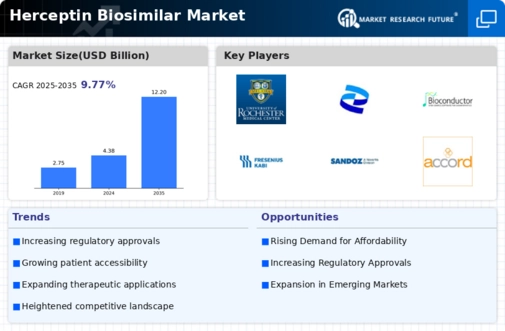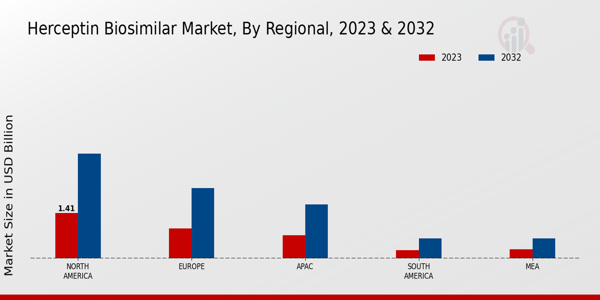Market Growth Projections
The Global Herceptin Biosimilar Market Industry is projected to experience substantial growth over the next decade. With an estimated market value of 4.38 USD Billion in 2024, it is expected to reach 12.2 USD Billion by 2035, reflecting a compound annual growth rate of 9.77% from 2025 to 2035. This growth trajectory indicates a robust demand for biosimilars, driven by factors such as increasing cancer prevalence, cost-effectiveness, and regulatory support. As the market evolves, it is likely to attract significant investments, further enhancing its potential and ensuring a diverse range of treatment options for patients.
Increasing Cancer Prevalence
The rising incidence of breast cancer globally drives the demand for Herceptin biosimilars. As breast cancer remains one of the most common cancers among women, the Global Herceptin Biosimilar Market Industry is poised for growth. In 2024, the market is valued at approximately 4.38 USD Billion, reflecting the urgent need for effective treatments. The availability of biosimilars provides a cost-effective alternative to the original Herceptin, making treatment more accessible to patients. This trend is expected to continue as healthcare systems increasingly prioritize affordable cancer therapies, potentially leading to a more significant market presence by 2035.
Growing Awareness and Acceptance
Increased awareness and acceptance of biosimilars among healthcare professionals and patients significantly influence the Global Herceptin Biosimilar Market Industry. Educational initiatives and outreach programs are essential in dispelling misconceptions about biosimilars, fostering confidence in their use. As more healthcare providers recognize the efficacy and safety of biosimilars, patient adoption is likely to rise. This growing acceptance is crucial for market expansion, as it encourages healthcare systems to incorporate biosimilars into treatment protocols. The trend towards embracing biosimilars is expected to continue, contributing to the overall growth of the market.
Cost-Effectiveness of Biosimilars
The economic advantages of biosimilars significantly influence the Global Herceptin Biosimilar Market Industry. With healthcare costs escalating, biosimilars offer a more affordable option for patients and healthcare providers. The introduction of Herceptin biosimilars allows for competition in pricing, which can lead to reduced treatment costs. This is particularly relevant in regions where healthcare budgets are constrained. As the market evolves, the cost savings associated with biosimilars are likely to attract more patients, thereby expanding the market. Projections indicate that by 2035, the market could reach 12.2 USD Billion, underscoring the financial benefits of these alternatives.
Regulatory Support for Biosimilars
Regulatory bodies worldwide are increasingly supportive of biosimilars, which positively impacts the Global Herceptin Biosimilar Market Industry. Streamlined approval processes and guidelines for biosimilars facilitate their entry into the market, enhancing competition and availability. This regulatory environment encourages pharmaceutical companies to invest in biosimilar development, leading to a broader range of treatment options for patients. As regulations continue to evolve, the market is likely to see a surge in new entrants, fostering innovation and potentially improving patient outcomes. This supportive framework is essential for the sustained growth of the biosimilar market.
Technological Advancements in Biologics
Advancements in biotechnology play a crucial role in the development of Herceptin biosimilars, impacting the Global Herceptin Biosimilar Market Industry. Innovations in manufacturing processes and analytical techniques enhance the ability to produce high-quality biosimilars that closely mimic the original biologics. These technological improvements not only ensure efficacy and safety but also reduce production costs, making biosimilars more attractive to manufacturers. As technology continues to progress, the market is likely to witness an influx of new biosimilars, further driving growth and expanding treatment options for patients with breast cancer.





















